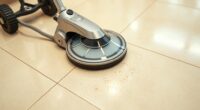To keep shop aisle edges looking pristine, use angled brushes or narrow hand brooms to reach into corners and along baseboards. Follow up with microfiber cloths or damp tools to remove dust and grime, paying special attention to tight spaces around fixtures. Regularly inspect your tools to verify they’re effective and safe. If you want to discover more expert tricks for maintaining a spotless and safe shopping environment, keep exploring top techniques.
Key Takeaways
- Use angled brushes or narrow hand brooms to easily reach and clean along baseboards and tight corners.
- Incorporate microfiber cloths after sweeping to trap dust and prevent debris from settling back.
- Apply a damp cloth or specialized baseboard cleaner for stubborn grime buildup on baseboards.
- Regularly inspect and maintain cleaning tools to ensure effectiveness and prevent spreading dirt.
- Schedule consistent edge cleaning routines to prevent dust accumulation and maintain a tidy aisle appearance.

Keeping shop aisles tidy is essential for safety and customer satisfaction, and that starts with edge cleanup. One of the most overlooked areas in maintaining a clean store is the baseboards and edges along the aisles. Properly cleaning these spots not only improves the overall appearance but also helps prevent accidents caused by accumulated dust, debris, or spills. To do this effectively, you need to understand and implement the right safety precautions and utilize the appropriate cleaning tools.
First, safety should always be your top priority. When working along edges and baseboards, ensure the floor is dry and free of obstructions. Use caution to avoid slips, trips, or falls—especially if you’re using ladders or step stools to reach higher spots. Wear gloves to protect your hands from dust, cleaning chemicals, or sharp edges, and always follow the manufacturer’s instructions when handling cleaning agents. If you’re using chemical cleaners, make sure the area is well-ventilated to prevent inhaling fumes. Keep a first aid kit nearby, just in case, and never rush your work—taking your time minimizes the risk of accidents.
Prioritize safety by keeping floors dry, wearing gloves, and following chemical instructions to prevent accidents during edge cleanup.
Equipping yourself with the right cleaning tools makes edge cleanup more efficient. A durable, angled brush or a narrow hand broom allows you to reach into tight corners and along baseboards without straining your back. Microfiber cloths are excellent for wiping down surfaces after sweeping, as they trap dust and dirt better than traditional rags. For stubborn grime, a slightly damp cloth or a specialized baseboard cleaning tool can make a big difference. For larger debris or spills, a lightweight vacuum with a crevice attachment is ideal for reaching along edges without spreading dirt elsewhere. Many pros also recommend using a handheld steamer for deep cleaning, especially in high-traffic areas where buildup is persistent. Additionally, understanding the importance of cleaning protocols helps maintain a consistently safe environment.
Consistency is key in maintaining a safe, clean shop environment. Regularly scheduled edge cleanup prevents dust and debris from accumulating, reducing the need for aggressive scrubbing or chemical use. Incorporate these tasks into your daily or weekly routines, and always double-check that your cleaning tools are in good condition—worn-out brushes or dirty cloths diminish effectiveness and can spread dirt around. When cleaning along baseboards and edges, remember to pay attention to corners and around fixtures, where dust tends to gather. Using the right tools and adhering to safety precautions ensures your edge cleanup is thorough, safe, and contributes to a welcoming shopping environment.
Frequently Asked Questions
What Tools Are Best for Edge Cleanup in Tight Spaces?
For edge cleanup in tight spaces, you should use corner brushes and detail scrapers. Corner brushes are perfect for reaching into corners and along edges, while detail scrapers help remove stubborn debris without damaging surfaces. Both tools give you precise control and make the job quicker. Keep a small set of these handy, and you’ll find it easier to keep shop aisles spotless and well-maintained.
How Often Should Baseboards Be Cleaned in Shop Aisles?
You should clean your shop aisle baseboards at least once a month as part of your maintenance schedule. Regular cleaning frequency prevents dust, dirt, and debris from accumulating, making it easier to maintain a tidy environment. If your shop experiences high foot traffic or spills, consider increasing cleaning frequency to every two weeks. Consistent upkeep prevents buildup, preserves the appearance of your baseboards, and ensures a safer, cleaner workspace for everyone.
Can DIY Methods Replace Professional Edge Cleanup Techniques?
DIY shortcuts can help you maintain baseboards, but they can’t fully replace professional edge cleanup techniques. While you might use simple tools like a vacuum or a microfiber cloth, pros use specialized brushes and detailed methods for a flawless finish. If you want a truly clean and polished look, investing in professional techniques guarantees thoroughness and durability, especially in high-traffic shop aisles. DIY can help between professional cleanings but isn’t a complete substitute.
Are There Eco-Friendly Products for Baseboard Cleaning?
Yes, there are eco-friendly solutions for baseboard cleaning. You can choose biodegradable cleaners that are safe for the environment and gentle on surfaces. Look for products labeled as natural or plant-based, which effectively remove dust and grime without harmful chemicals. Using these eco-friendly options helps protect your home and the planet, making your cleaning routine more sustainable while still achieving a spotless look for your baseboards.
How Do You Prevent Damage to Baseboards During Cleaning?
Think of your baseboards as delicate artwork—you don’t want to scratch their surface. To prevent damage, set up protective barriers like painter’s tape or foam guards along the edges. Use gentle cleaning methods, like a soft cloth or a sponge dipped in mild, eco-friendly soap. Avoid harsh chemicals and abrasive tools. This careful approach guarantees your baseboards stay pristine while you clean, like a gentle breeze preserving a garden.
Conclusion
So, after all that fuss about baseboard tricks and edge cleanup, you’d think it’s the most glamorous part of your shop. Turns out, the real magic is in the details you probably ignore—like those tiny, pesky crumbs in aisle corners. Who knew that perfect shop aisle could hinge on a few well-placed swipes? Ironically, the tiniest effort makes the biggest difference, proving sometimes, the devil really is in the details. Happy cleaning!









